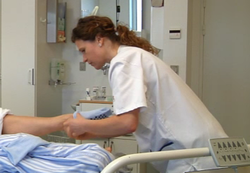The learning of practical skills in nursing

The complexity of practical skills requires a comprehensive approach in learning. It is also important to acknowledge that learning takes time. During nursing education the learning of practical skills takes place both in clinical skills centers and in the clinical setting. After graduation nurses must continue to improve their performance of practical skills in the clinical setting, and to learn new skills as they emerge in the wake of developments in nursing and medical treatment (Ewertsson et al., 2015).
The learning process involves many aspects that must be considered in order to develop good arenas for learning. Examples of these aspects are: the necessity to acquire appropriate knowledge, opportunities to observe others, to practice in varied settings, to receive feedback and to reflect on own and others performance of practical skills (Ravik et al., 2017 a, b). Traditionally, research in practical skill learning has been preoccupied with technical aspects of learning in the clinical skill center. This is partly due to a behaviouristic understanding of what it means to perform practical skills where speed, fluency and accuracy in manual movement have been central concepts (Bjørk, 1999). We appreciate that this knowledge is also necessary, but advocate for research that also takes into account the relational and situational aspects inherent in practical nursing skills, as illustrated in the Model of Practical Skill Performance (Bjørk et al., 2013).
Bjork IT. Hands-on nursing: new graduates' practical skill development in the clinical setting. Dissertation (Ph.D). Institute of Nursing Science, University of Oslo, Norway, 1999
Bjørk IT, Lomborg K, Nielsen C, Brynildsen G, Skovgaard Frederiksen AM, Reiersom IÅ, Sommer I, Stenholt B. From theoritical model to prakctice use: an example of knowledge translation. Journal of Advanced Nursing 2013, 69, 2336-2347.
Ewertsson M, Gustafsson M, Blomberg K, Holmstrôm. Walking the bridge: Nursing students’ learning in clinical skill laboratories. Nurse Education in Practice. 2015 Jul;15(4):277-83.
Ravik M, Havnes A, Bjørk IT. Defining and compairing learning actions in two simulation modalities: students training on a latex arm and on each orther's arms. Journal of Clinical Nursing. February 2017 a 26(23-24)
Ravik, M., Havnes, A., Bjørk, I.T. (2017). Conditions affecting the performance of peripheral vein cannulation during hospital placement: A case study. Nursing Research and Practice. November 2017 b (1-10)
The learning process involves many aspects that must be considered in order to develop good arenas for learning. Examples of these aspects are: the necessity to acquire appropriate knowledge, opportunities to observe others, to practice in varied settings, to receive feedback and to reflect on own and others performance of practical skills (Ravik et al., 2017 a, b). Traditionally, research in practical skill learning has been preoccupied with technical aspects of learning in the clinical skill center. This is partly due to a behaviouristic understanding of what it means to perform practical skills where speed, fluency and accuracy in manual movement have been central concepts (Bjørk, 1999). We appreciate that this knowledge is also necessary, but advocate for research that also takes into account the relational and situational aspects inherent in practical nursing skills, as illustrated in the Model of Practical Skill Performance (Bjørk et al., 2013).
Bjork IT. Hands-on nursing: new graduates' practical skill development in the clinical setting. Dissertation (Ph.D). Institute of Nursing Science, University of Oslo, Norway, 1999
Bjørk IT, Lomborg K, Nielsen C, Brynildsen G, Skovgaard Frederiksen AM, Reiersom IÅ, Sommer I, Stenholt B. From theoritical model to prakctice use: an example of knowledge translation. Journal of Advanced Nursing 2013, 69, 2336-2347.
Ewertsson M, Gustafsson M, Blomberg K, Holmstrôm. Walking the bridge: Nursing students’ learning in clinical skill laboratories. Nurse Education in Practice. 2015 Jul;15(4):277-83.
Ravik M, Havnes A, Bjørk IT. Defining and compairing learning actions in two simulation modalities: students training on a latex arm and on each orther's arms. Journal of Clinical Nursing. February 2017 a 26(23-24)
Ravik, M., Havnes, A., Bjørk, I.T. (2017). Conditions affecting the performance of peripheral vein cannulation during hospital placement: A case study. Nursing Research and Practice. November 2017 b (1-10)
